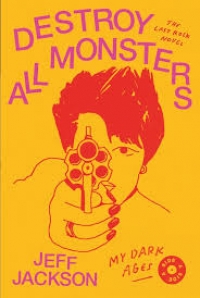Destroy All Monsters by Jeff Jackson
 Friday, March 1, 2019 at 6:43AM
Friday, March 1, 2019 at 6:43AM 
Published by Farrar, Straus & Giroux on October 16, 2018
I started reading Destroy All Monsters three times before I found myself in the right mood to settle into the story. When I did, the novel wouldn’t let me go. The plot is strange and disturbing, but disturbance is sometimes necessary to shake us out of our complacency, to make us see the world in a different way. Make of the story what you will — and I’m certain that different readers will interpret it in different ways — I found it to be compelling even as I wondered whether I was truly grasping its intended meaning.
The first and longer installment of Destroy All Monsters is "My Dark Ages." It imagines that apparently random shootings at music venues are a national epidemic — a discomforting thought that requires little imagination. The killings serve no obvious agenda (they do not appear to be political) but they might be inspired by the dark rage that lurks within high-energy rock.
The first section of "My Dark Ages" focuses on an industrial city called Arcadia, where a shooter enters a club and targets a band. The second section focuses on a different Arcadia band in the aftermath of the shooting. Its guitar player, Florian, was the best friend of a band member who dies in the first section. The novel begins to gain power as it describes Florian and his band coping with their emotional turmoil. They need to decide whether to play again, not because they are afraid of being shot, but because they might prove unworthy. At the same time, they are conflicted: should they play as a tribute to the fallen, or should they make the moment their own?
Xenie, the dead musician’s girlfriend, plays a key role. Hanging out with a band manager, she ponders whether the attacks on bands are connected. Are they a commentary, she wonders, on how bad local bands have become (“The smarmy bluegrass revivalists in the Deep South. The listless jam band in the Midwest”)? Has music been destroyed by its performance and consumption?
The story becomes tense as Florian’s band prepares to play in the newly reopened club. Florian and Xenie are at odds about what this performance should be and how the dead musician should be remembered. The story takes an unexpected turn at that point. It becomes a meditation on the meaning of courage as Xenie and Florian each contemplate an act that might be seen as courageous or cowardly.
In the print version of Destroy All Monsters, the last third of the novel, in the form of a novella titled “Kill City,” has a separate cover, like an old Ace Double. Flip the book over and you get a new book, or at least a new novella that tells a different version of "My Dark Ages." I assume the idea is that the book, like an old record, has an A-side and a B-side, hence the picture of a vinyl 45 next to the subtitles.
"Kill City" begins with a noticeably confused boy who pulls a pistol and starts firing in a North Carolina veterans’ hall filled with garage and jam bands. We start to see a pattern in killings that spread through decaying industrial cities. The killers are dazed, detached loners who might be aching for a performance of their own. One of them claims to be shooting in self-defense.
The final shooting in “Kill City” is the same Arcadia shooting that opens the novel, except that the victims are different. The mourner in the first story becomes the mourned in the second and the band manager is a different gender. What should the reader make of that? I’m not certain, although seeing what is essentially the same story through the eyes of altered characters contributes to a greater understanding of the novel’s themes. The changes are important: a funeral in the first novel is very different from the counterpart’s funeral in the second novel, leading to meaningful questions about the nature and purpose of death rituals.
The aftermath of death is one of the novel’s primary themes. When do we let go? Do we let go of too much of our loved ones or not enough? The characters understandably spend a good bit of time thinking about death and their insights are valuable. Guns are another theme, from hunters gleefully culling the deer population to killers who behave like zombies when they pick up a gun. America’s fascination with killers, the ease with which they become celebrities, is a related theme.
Destroy All Monsters is told in matter-of-fact sentences that sometimes achieve an elegant purity of storytelling. Point of view shifts, sometimes relating events in the second person, as if a narrator is describing actions to the character who performs them. Both in style and content, Destroy All Monsters is interesting and edgy. I think it is also rewarding, although working out its meaning may require a second close reading.
RECOMMENDED
Reader Comments